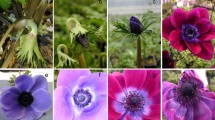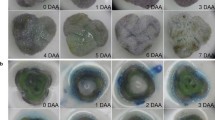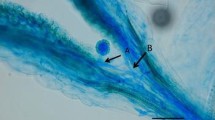Summary
A simple medium is described which supports the germination of Brassica pollen in vitro. The method is completely reliable and the percentage germination achieved is comparable to that found on a compatible stigma. The pollen tubes produced attain lengths equal to those growing in the style and exhibit similar growth kinetics. The major difference between this medium and other less-reliable media is the addition of 1 mM Tris. The efficacy of Tris is shown to be due in part to the establishment of an optimum pH but an “amine effect” is also identified. The optimum pH for growth in vitro may be different from that encountered on the stigma. Atmospheric concentration of CO2 and pollen population density are also shown to have pronounced effects on germination in vitro.
Germination in vitro is not significantly affected by prior incubation on the stigma surface. Neither crossnor self-stigmas exert any apparent influence on pollen viability in this respect. Similarly the numbers of tube initials produced in atmospheres of 98% relative humidity (RH) are not altered by such treatments. Conversely, incubation in germination medium and in 98% RH prior to pollination appears to modify pollen-stigma interactions to some extent.
Stigma extracts added to the germination medium cause an increase in the rate of hydration of both cross- and self-pollen, but this effect is greater in the case of cross-pollen. Evidence for specific inhibition of self-pollen germination by stigma extracts added to the medium was not obtained. The relevance of these phenomena to current concepts of the mechanism of self incompatibility (SI) are discussed and a potential use of the medium in overcoming the SI response is suggested.
Similar content being viewed by others
References
Bar Shalom D, Mattsson O (1977) Mode of hydration as an important factor in the germination of trinucleate pollen grains. Bot Tiddskr 71:245–251
Brewbaker JL (1957) Pollen cytology and incompatiblity systems in plants. J Hered 48:271–277
Brewbaker JL, Majumder SK (1961) Cultural studies of the pollen population effect and the self-incompatibility inhibition. Am J Bot 48:457–464
Brewbaker JL, Kwack BH (1963) The essential role of calcium ion in pollen germination and pollen tube growth. Am J Bot 50:859–865
Carter AL, McNeilly T (1975) Effects of increased humidity on pollen growth and seed set following self-pollination in Brussels sprout (Brassica oleracea var. ‘gemmifera’). Euphytica 24:805–813
Carter AL, McNeilly T (1976) Increased atmospheric humidity postpollination: a possible aid to the production of inbred line seed from mature flowers in the Brussels sprout (Brassica oleracea var. & gemmifera’). Euphytica 25:531–536
Chiang MS (1974) Cabbage pollen germination and longevity. Euphytica 23:579–584
Dai Y-R, Kaur-Sawhney R, Galston AW (1982) Promotion by gibberellic acid of polyamine biosynthesis in internodes of light-grown dwarf peas. Plant Physiol 69:103–106
Dhaliwal AS, Malik CP, Singh MB (1981) Overcoming incompatibility in Brassica campestris L. by carbon dioxide, and dark fixation of the gas by self- and cross-pollinated pistils. Ann Bot 48:227–233
Dickinson DB (1978) Influence of borate and pentaerythritol concentrations on germination and tube growth of Lilium longiflorum pollen. J Am Soc Hort Sci 103:413–416
Dickinson HG, Moriarty JE, Lawson JR (1982) Pollen-pistil interaction in Lilium longiflorum: the role of the pistil in controlling pollen tube growth following cross- and self-pollinations. Proc R Soc London, Ser B 215:45–62
Dickinson HG, Roberts IN (1983) Cell surface receptors in the pollen-stigma interaction of Brassica oleracea. In: Garrod DR, Chadwick CM (eds) Receptors in plants and slime moulds. Marcell Dekker, New York (in press)
Ferrari TE, Wallace DH (1975) Germination of Brassica pollen and expression of incompatibility in vitro. Euphytica 24:757–765
Ferrari TE, Bruns D, Wallace DH (1981) Isolation of a plant glycoprotein involved with control of intercellular recognition. Plant Physiol 67:270–277
Ferrari TE, Lee SS, Wallace DH (1981) Biochemistry and physiology of recognition in pollen-stigma interactions. Phytopathology 71:752–755
Golynskaya EL, Bashkinova NV, Tomchuk NN (1976) Phytohaemagglutinins from the pistil of Primula as possible proteins of generative incompatibility. Sov Plant Physiol 23:69–76
Heslop-Harrison J (1978) Recognition and response in the pollen stigma interaction. In: Curtis ASG (ed) Cell-cell recognition. Symposia of the Society for Experimental Biology No 32. Cambridge University Press, Cambridge, pp 121–138
Heslop-Harrison J (1979) Aspects of the structure, cytochemistry and germination of the pollen of rye (Secale cereale L.). Ann Bot 44:SI 1–47
Heslop-Harrison J (1982) Pollen-stigma interaction and cross-incompatibility in the grasses. Science 215:1358–1364
Heslop-Harrison Y, Shivanna KR (1977) The receptive surface of the angiosperm stigma. Ann Bot 41:1233–1258
Hinata K, Nishio T, Himura J (1982) Comparative studies on S-glycoproteins purified from different S-genotypes in self-incompatible Brassica species. 2. Immunological specificities. Genetics 100:649–657
Hrabêtova E, Tupý J (1961) Respiration of apple pollen on different sugar substrates and the problem of the role of sucrose in pollen tube growth. Biol Plant 3:270–276
Johri BM, Vasil IK (1961) Physiology of pollen. Bot Rev 27:325–381
Kroh M (1956) Genetische und entwicklungs-physiologische Untersuchungen über die Selbssterilität von Raphanus raphistrum. Z Indukt Abstam Vererbungsl 87:365–384
Kroh M (1966) Reaction of pollen after transfer from one stigma to another. Züchter 36:185–189
Kroh M, van Bakel CHJ (1973) Incorporation of label into the intercellular substance of stylar transmitting tissue from Petunia pistils labelled with tritiated myo-inositol. An electron-microscopic and autoradiographic study. Acta Bot Neerl 22:106–111
Kwack BH (1964) On the role of calcium and other cations in pollen germination and tube growth. Bot Mag 77:327–332
Kwack BH, Kim I (1967) An improved method for culturing Tradescantia pollen tubes for chromosomal analysis. Cytologia 32:1–5
Nakanishii T, Hinata K (1973) An effective time for CO2 gas treatment in overcoming self-incompatibility in Brassica. Plant Cell Physiol 14:873–879
Nishio T, Hinata K (1982) Comparative studies on S-glycoproteins purified from different S-genotypes in self-incompatible Brassica species. 1. Purification and chemical properties. Genetics 100:641–647
Roberts IN, Stead AD, Ockendon DJ, Dickinson HG (1979) A glycoprotein associated with the acquisition of the self-incompatibility system by maturing stigmas of Brassica oleracea. Planta 146:179–183
Roberts IN, Stead AD, Ockendon DJ, Dickinson HG (1980) Pollen stigma interactions in Brassica oleracea. Theor Appl Genet 58:241–246
Shivanna KR, Heslop-Harrison J, Heslop-Harrison Y (1981) Heterostyly in Primula. 2. Sites of pollen inhibition, and effects of pistil constituents on compatible and incompatible pollen tube growth. Protoplasma 107:319–337
Speranza A, Calzoni GL (1980) Compounds released from incompatible apple pollen during in vitro germination. Z Pflanzenphysiol 97:95–102
Speranza A, Calzoni GL, Bagni N (1982) Effect of exogenous polyamines on in vitro germination of apple pollen. In: Smith HG (ed) Second International Pollen Symposium, Lake Garda, June 1982. Academic Press, London, pp 82–90
Stanley RG, Linskens HF (1974) Pollen: biology, biochemistry, management. Springer, Berlin Heidelberg New York
Author information
Authors and Affiliations
Additional information
Communicated by H. F. Linskens
Rights and permissions
About this article
Cite this article
Roberts, I.N., Gaude, T.C., Harrod, G. et al. Pollen-stigma interactions in Brassica oleracea; a new pollen germination medium and its use in elucidating the mechanism of self incompatibility. Theoret. Appl. Genetics 65, 231–238 (1983). https://doi.org/10.1007/BF00308074
Received:
Issue Date:
DOI: https://doi.org/10.1007/BF00308074




